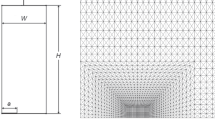Abstract
Computer modeling of mixed-mode crack propagation has rarely been attempted. This is because of the difficulty in updating the geometrical description to represent the changing crack geometry. The development of two interactive, graphical fracture propagation systems is described here. The Finite Element Fracture Analysis Program—Graphical (FEFAP-G) is a two-dimensional fracture propagation system. The BEM3D is a three-dimensional boundary element fracture propagation system.
In addition, the implementation of the BEM3D analysis program in a configuration formed by an FPS-264 processor attached to a VAX-11/750 used as host computer is described. The results show that a realistic three-dimensional boundary element analysis of crack propagation is not only feasible with the aid of attached processors, but it can have its total time reduced by factors of the order of hundreds when compared to VAX alone statistics.
In an example problem concerning fatigue crack propagation in a stiffened wing skin, both FEFAP-G and the BEM3D are employed to illustrate the utility of the fracture propagation systems.
Similar content being viewed by others
References
Engle Jr.; R.M. (1970) Cracks, a FORTRANIV Digital computer program for crack propagation analysis. AFFDL-TR-70-107, October
Failure Analysis Associates. BIGIF Fracture Mechanics Code for Structures. Principal investigators: P.M. Besuner; D.C. Peters; R.C. Cipolla. EPRI NP-838, Project 700-1, Key Phase Report, Manual 1, July 1978
Chang, J.B.; Szamossi, M.; Liu, K.-W. (1981) A user's manual for a detailed level fatigue crack growth analysis computer code, Volume I—The CRKGRO program. AFWAL-TR-81-3903
Chang, J.B.; Szamossi, M.; Liu, K.-W. (1981) A user's manual for a computer program to predict fatigue crack growth on flight-by-flight basis—The FLTGRO program. AFWAL-TR-81-3904
Atluri, S.N.; Bass, B.R.; Bryson, J.W.; Kathiresan, K. (1982) OR-FLAW: A finite element program for direct evaluation of K-factors for user-defined flaws in plates, cylinders, and pressure-vessel nozzle corners. NUREG/CR-2494, ORNL/CSD/TM-165 April
Gerstle, W.H. (1986) Finite and boundary element modelling of crack propagation in two and three dimensions using interactive computer graphics. Ph.D. thesis, Cornell University, Ithaca, NY, January
Perucchio, R.; Ingraffea, A.R. (1985) An integrated boundary element analysis system with interactive computer graphics for three-dimensional linear-elastic fracture mechanics. Comput. Struct. 20(1–3), 157–171
Saouma, V.E. (1981) Interactive finite element analysis of reinforced concrete. Ph.D. thesis, Cornell University, Ithaca, NY, January
Saouma, V.E.; Ingraffea, A.R. (1981) Fracture analysis of discrete cracking. Colloq. Adv. Mech. Reinf. Concrete, IABSE, Delft, 393–416
Han, T.-Y. (1981) A general two-dimensional, interactive graphical finite element preprocessor for a virtual storage environment. M.S. thesis, Cornell University, Ithaca, NY
Barsoum, R.S. (1976) On the use of isoparametric finite elements in linear fracture mechanics. Int. J. Num. Meth. Eng. 10, 25–37
Erdogan, F.; Sih, G.D. (1963) On the crack extension in plates under plane loading and transverse shear. ASME J. Bas. Eng. 85, 519–527
Hussain, M.A.; Pu, S.L.; Underwood, J.H. (1974) Strain energy release rate for a crack under combined Mode I and Mode II. Fracture Analysis, ASTM STP 560, pp. 2–28
Sih, G.C. (1974) Strain energy density factor applied to mixed-mode crack problems. Int. J. Fract. 10, 305–321
Gerstle, W.H.; Ingraffea, A.R. (1985) Error control in three-dimensional crack modelling using boundary element method. Advanced Topics in Boundary Element Analysis, ASME AMD 72, pp. 205–211
Rolfe, S.T.; Barsom, J.M. (1977) Fracture and fatigue control in structures. In: Applications of Fracture Mechanics. Englewood Cliffs, NI: Prentice-Hall
Hajjar, J.F. (1984) General-purpose three-dimensional colorpostprocessing for engineering analysis. M.S. thesis, Cornell University, Ithaca, NY
Gerstle, W.H.; Ingraffea, A.R. (1986) Boundary element modeling of crack propagation in three dimensions. In: Proceedings of the Second Boundary Element Technology Conference (Eds. J. Connors; C. Brebbia), Cambridge, MA, pp. 651–662, June
Author information
Authors and Affiliations
Rights and permissions
About this article
Cite this article
Gerstle, W.H., Martha, L.F. & Ingraffea, A.R. Finite and boundary element modeling of crack propagation in two and three dimensions. Engineering with Computers 2, 167–183 (1987). https://doi.org/10.1007/BF01201264
Issue Date:
DOI: https://doi.org/10.1007/BF01201264




